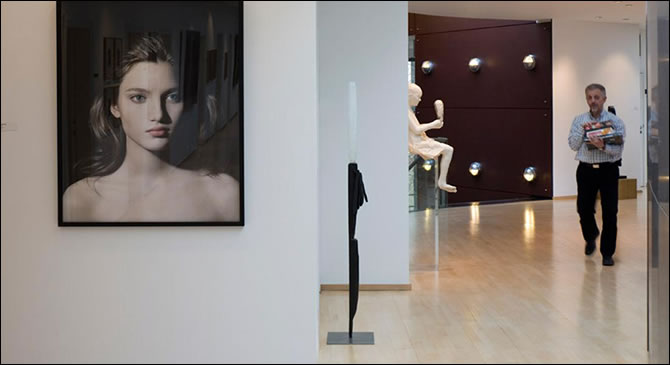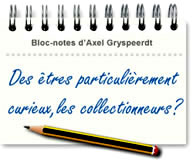
The art collection and the Lhoist Group
Pascale van Zuylen, Responsable de Communication, Lhoist
The Lhoist Group, a world leader in lime, dolomite and minerals, is an enterprise established by the Lhoist family 125 years ago.
In the 80s, the Group increased its international dimension and decided to order a new building for its headquarters. The art collection started in the same time the building was planned.
The collection is mainly composed by photographs (conceptual, documentary with Magnum Photographs) and also by sculptures, paintings, drawings and a few number of videos.
The particularity and quality of Lhoist Group collection is the Commissioned Artworks from artists of international renown, including: Tony Cragg, Anish Kapoor, James Turrell, Not Vital, Ulrich Rückriem, Josef Koudelka, Bernd and Hilla Becher, Rodney Graham…
How is the selection process working?
At the very beginning of the collection, purchases were organized according to a list made by art critic Pierre Apraxine who suggested a new and affordable medium: the photography.
Purchases are made according to crushes ; there is no selection committee and no special budget dedicated per year to the collection.
Since a few years purchases strongly decreased because of new invest.
The collection is focusing on multiples or reprints (for offices situated in most distant countries where is more difficult to check, to hang, to take down or to clean pieces)
Why is it important for Lhoist to own an art collection?
Art in Corporate is just UPLIFTING!
Lhoist is an international Group of 6000 employees over the world and 40 different nationalities with their own culture and background. This melting pot of culture is a major asset for the company and an exceptional source of creativity and innovation. Artists share and express the same values.
Artists play an important role by giving rise to curiosity and the spirit of openness.
The collection is a window into the world
……………………… a factor of integration
……………………… a discovery of other cultures
……………………… helps us to accept the difference in mindset
……………………… a nice place for hosting customers
……………………… helps us to embrace change as a necessary partner for progress
The collection develops a sense of belonging
How do you integrate your corporate art collection in the overall communication (internal and external) of the group? Is it separate or is it plenty part of it?
Vector of communication, the collection is part of an internal cultural policy
-The collection is exhibited at our Limelette Headquarters and in different European offices (main entrance, meeting rooms, offices, lunch room, corridors…) employees can have a work in his office.
-We ask for an outside curator annually (or after 18 months) to make a new selection of works with a new topic (Growth and Form by Dirk Snauwaert, 2014 is in link with 125th anniversary).
- Screen saver (with selection of images from the current exhibition) on view all over countries.
- Lhoist invites staff and families to discover major museums; guided tour for adults and creative workshops for employee's children. It's a great opportunity to join colleagues from other countries.
The collection and the external communication
- Visit of the collection is only for clients, shareholders and important business relationships (the collection is not open to the public).
- Catalogues (about photography, sculptures, Limelette's exhibitions) or book commissioned to artists (Koudelka about views of plants and carriers) serve as presents. - Images posted on the Web site are only there to illustrate the chapter of philosophy and values.
- To illustrate the Christmas card.
Advices for a company who would want to start/manage a collection?
Select an adviser to get all information you need about artists and art market.
Favor the quality for a specific budget.
Choose pieces with criteria (no sound work, no offensive images...for example).
What is IACCCA and why does this association exist? What should policy makers do to encourage these initiatives?
International Association of Corporate Collections of Contemporary Art
IACCCA brings together the curators of corporate contemporary art collections worldwide with a view to:
-share expertise and best practices
-foster adequate and innovative actions in a constantly changing environment
-gain international perspective and visibility
-benefit from all advantages of ICOM membership and other special partnerships
-put light on art collection as a tool for corporate social responsibility
Colloque Collectiana, Bruxelles, 22 mars 2016

|
© 2012 collectiana.org - Fondation pour l'étude et le développement des collections d'art et de culture - Fondation d'utilité publique - Tous droits réservés







